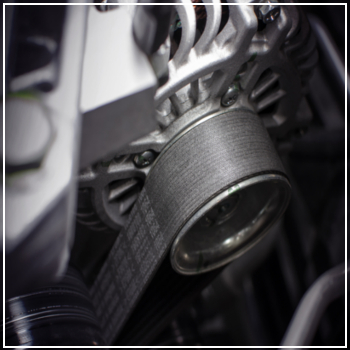What’s Wrong With the Timing Belt?
 You bring your car in for a routine service, and the mechanic tells you there's a problem with the timing belt. You’ve heard the term before, but you’re not exactly sure what it does. What could be going on?
You bring your car in for a routine service, and the mechanic tells you there's a problem with the timing belt. You’ve heard the term before, but you’re not exactly sure what it does. What could be going on?
What Is a Timing Belt?
The timing belt is one of the most important parts inside your engine. Think of it as the brain that coordinates the movement of key components. It ensures that the camshaft (which controls the valves) and the crankshaft (which moves the pistons) work in perfect sync. This synchronization is crucial to prevent the engine from self-destructing during its four-stroke cycle—intake, compression, power, and exhaust.
Most timing belts are made of reinforced rubber or synthetic materials with teeth or ribbing to maintain proper alignment. They're located at the front of the engine and are exposed to heat, pressure, and constant motion. Over time, this leads to wear and tear. If the belt breaks, your engine will stop running immediately, and in some cases, it can cause serious internal damage.
It’s recommended to replace the timing belt every 60,000 to 100,000 miles, depending on your vehicle's make and model. However, not all cars use a timing belt—some have a timing chain, which typically lasts the lifetime of the engine.
Common Signs of a Failing Timing Belt
If you start noticing unusual behavior in your car, it might be related to your timing belt. Here are some symptoms to watch out for:
1. Engine Performance Problems
- Engine runs roughly or loses power: A misaligned or worn timing belt can cause the engine to feel sluggish or shake while driving.
- Ticking noise when the engine is running: This sound often indicates a damaged belt or low oil pressure.
- Engine won’t start: If the belt is completely broken, the engine may turn over but not fire up. In some cases, internal damage can occur.
- Check Engine light is on: The car’s computer may detect issues with emissions or timing, even if you don’t hear anything unusual.
2. Oil-Related Issues
- Oil pressure drops: A faulty timing belt can affect the camshaft, leading to reduced oil flow and potential engine damage.
- Oil leaks: Loose or damaged parts around the timing belt can cause oil to leak, which can accelerate belt deterioration.
3. Water Pump Failure
Some timing belts are connected to the water pump. If the water pump fails, it can put extra stress on the timing belt, potentially causing it to break. Regular maintenance of your cooling system is essential to protect other critical components.
4. Visible Damage
If you're comfortable opening the hood, look for these signs of wear:
- Missing or damaged teeth
- Cracks or splits along the belt
- Worn edges or oil stains
These problems can be caused by poor installation, extreme temperatures, or incorrect tension. If you spot any of these, it’s best to get your car checked right away.
If you're experiencing any of these issues, don't ignore them. A failing timing belt can lead to expensive repairs or even total engine failure. To ensure your car stays running smoothly, schedule a diagnostic appointment today at our Naugatuck location. Your engine will thank you!
we are OEM tubing pipeline factory ,we could produing what you need ,for car use ,waiting for your request in anytime.
We Can provide customers with customized services
Polyamide brake tube,PA corrugated tube, Automobile wire tube
JiLin TAIYU Technology Manufacturing Co., LTD , http://www.automobilepipe.com